The global trading app market has matured rapidly, driven by mobile-first investors, easier access to global exchanges, and demand for real-time portfolio management. Investors now expect more than just stock buying. They want seamless execution across borders, multi-currency support, and access to complex instruments through a single interface.
Interactive Brokers has become a global benchmark for cross-border trading platforms. It supports over 135 markets, offers multi-currency wallets, fractional trading, and advanced tools like automated trading, risk management analytics, and portfolio diversification. Its strong compliance framework and robust trading infrastructure make it suitable for both retail and institutional clients.
Businesses looking to build a similar app in the UAE must prepare for a development cost ranging from AED 735,000 to AED 5.5 million (approximately $200,000 to $1.5 million), depending on platform complexity, features, and compliance requirements. This includes everything from multi-currency support, market data feeds, and biometric security to DFSA-aligned KYC/AML and a scalable trading infrastructure.
In this blog, we will break down the cost to develop a cross-border trading app like Interactive Brokers in the UAE, along with its key features, cost drivers, and hidden expenses.
Interactive Brokers at a Glance: Why It’s a Global Standard
Interactive Brokers has set the benchmark for cross-border trading platforms by offering access to over 135 markets in 33 countries and 23 currencies. Its appeal lies in its low-cost trading, real-time market data, smart routing, and strong compliance framework. The platform supports a broad range of asset classes, like stocks, options, futures, forex, bonds, and ETFs, making it ideal for diverse investor profiles worldwide.
Interactive Brokers is built to serve two core user groups with distinct needs and interfaces:
- Retail traders use the platform to access international markets, manage multi-currency accounts, and execute trades with advanced tools like algorithmic trading, portfolio rebalancing, and risk alerts. The Trader Workstation (TWS) interface provides deep technical analysis, custom strategies, and real-time data to support individual trading decisions.
- Institutional investors and advisors benefit from features like bulk order execution, white-labeled account management, regulatory reporting, and dedicated APIs for trade automation and client portfolio handling. The platform supports hedge funds, proprietary trading firms, family offices, and financial advisors managing multiple accounts under one roof.
Key Stats & Figures Related to Interactive Brokers
Here are the key stats and figures related to Interactive Brokers in bullet format:
Interactive Brokers vs Others: UAE Trading App Landscape Breakdown
This comparison looks at how Interactive Brokers stacks up against key competitors operating in the UAE. We evaluated core financials, user base, market presence, feature set, and monetization strategies to guide businesses considering market entry or app development.
| Platform | Annual Revenue (2024) | Active Users | Key Revenue Streams | Market Coverage | Feature Highlights | Cost to Build Similar Platform |
| Interactive Brokers | $4.8B+ (Global) | 3.3M+ | Commissions, interest, market data | 135+ exchanges | Margin accounts, algo trading, global FX, KYC compliance | $600K–$1.5M (UAE build) |
| Saxo Bank | $800M+ (Global) | 850K+ | Spread markups, managed portfolios | 25+ countries | Multi-asset, white-label APIs, investor education | $500K–$1.2M |
| eToro | $1.2B+ (Global) | 3M+ UAE users | Commission-free trading, social copy | 100+ markets | Social trading, crypto, copy portfolios, learning tools | $450K–$1M |
| Sarwa | $20M+ (UAE-focused) | 100K+ | AUM % fees, premium accounts | UAE & GCC | Robo-advisory, auto-invest, ESG portfolios | $300K–$600K |
| Zerodha (India) | $350M+ | 12M+ | Discount brokerage, subscriptions | India | DIY trading tools, charting, bulk orders | $250K–$700K (GCC expansion) |
Key Features That Define Interactive Brokers
A cross-border trading app like Interactive Brokers needs to do much more than just allow users to buy and sell. It must operate seamlessly across countries, support multiple currencies, and comply with various financial regulations, all while remaining simple for users to navigate. Partnering with a mobile app development company in Dubai can help you build such a platform with the right mix of localisation, security, and global functionality. Below are the core features that define how Interactive Brokers works and what your app should aim to include.
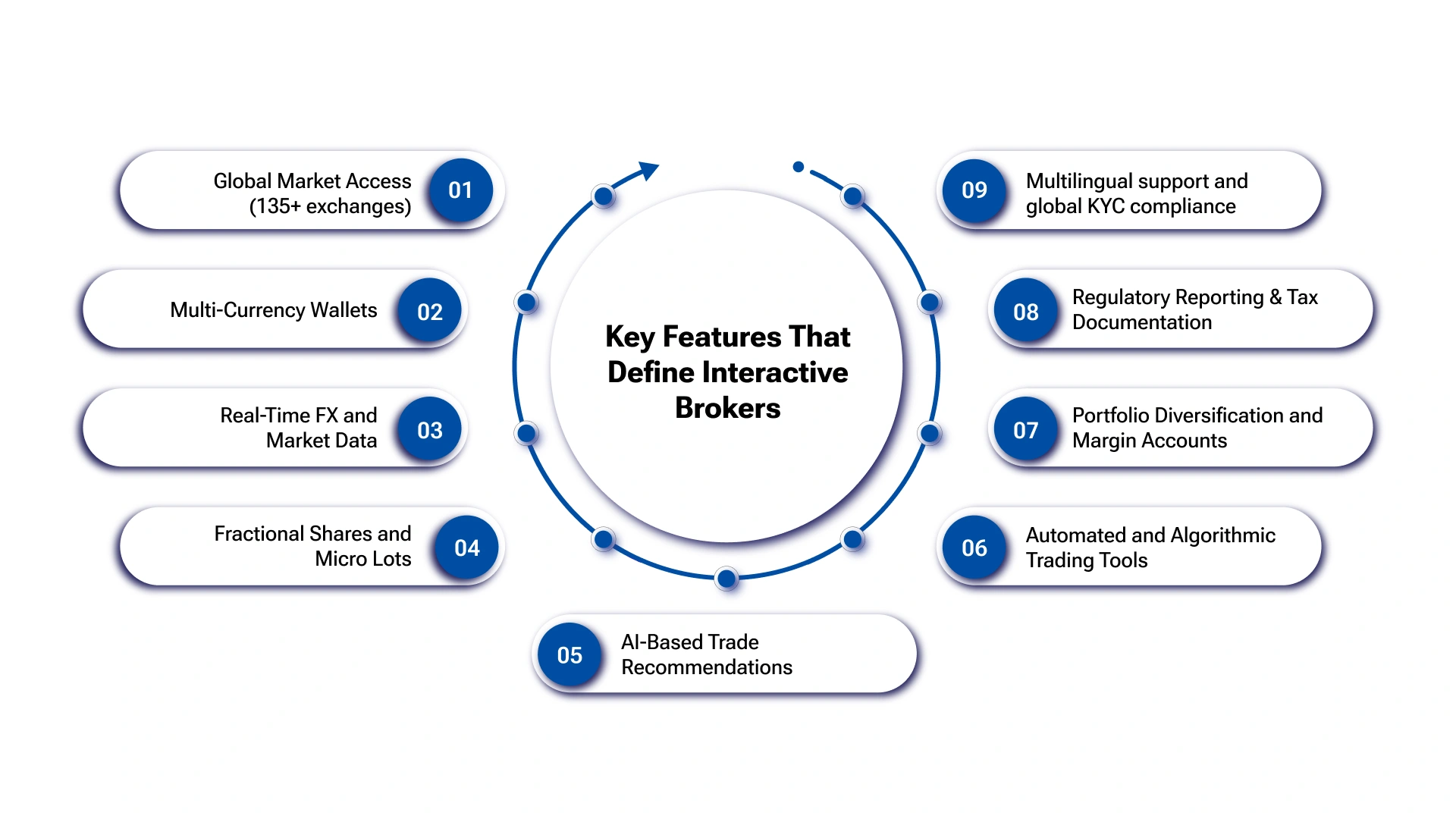
Global Market Access (135+ exchanges)
Users can trade across more than 135 global exchanges, enabling exposure to the US, UK, Europe, Asia, and the Middle East through a single platform. This feature alone can expand your users’ investment reach by 40–60%, increasing retention among high-value global traders.
Multi-Currency Wallets
The app allows users to hold money in different currencies like USD, EUR, AED, or JPY. They can easily convert between them when making trades in international markets, saving on bank fees and delays. This reduces dependency on banks and improves transaction efficiency, boosting average transaction size by 25% or more.
Real-Time FX and Market Data
Live market data and FX rates empower users to react instantly to global market shifts. Apps offering institutional-grade data see a 30–50% reduction in trade decision time, which leads to more frequent trading and longer in-app engagement.
Fractional Shares and Micro Lots
Not everyone can afford high-value shares like Amazon or Tesla. With fractional shares, users can buy a small portion of a stock. This lowers the entry barrier and encourages more people to invest.
AI-Based Trade Recommendations
By using AI to suggest personalised trade ideas based on user activity and market movements, you can improve engagement significantly. Platforms that implement this see up to 38% higher user retention, as users return for tailored insights.
Automated and Algorithmic Trading Tools
Advanced traders can build their own trading strategies that run automatically. For example, they can set rules like “buy when this stock drops 5%.” The app follows these rules without the user having to monitor it all day.
Portfolio Diversification and Margin Accounts
Allowing users to manage multiple asset classes and trade on margin encourages more sophisticated investing. This results in higher deposits and larger trades, with some platforms seeing average portfolio size grow by 2–3x.
Regulatory Reporting & Tax Documentation
The app handles all the paperwork behind the scenes. It generates reports for tax filing and makes sure everything follows local financial rules in each country the user operates in.
Multilingual support and global KYC compliance
Since users come from different countries, the app supports multiple languages and verifies identities based on local laws. This makes onboarding smooth while keeping the platform legally compliant.
Estimated Feature Development Cost to Develop a Cross-Border Trading App Like Interactive Brokers
| Feature | Description | Estimated Cost (AED) |
| Global Market Access | Integrate APIs to trade across 135+ international stock exchanges | AED 440,000 – AED 735,000 ($120,000 – $200,000) |
| Multi-Currency Wallets | Allow users to store, convert, and use multiple currencies in real-time | AED 183,500 – AED 312,000 ($50,000 – $85,000) |
| Real-Time FX & Market Data | Stream live currency exchange rates and asset prices from different global markets | AED 220,500 – AED 367,000 ($60,000 – $100,000) |
| Fractional Shares & Micro Lots | Build the backend logic for partial share purchases and small-lot trading | AED 147,000 – AED 257,000 ($40,000 – $70,000) |
| AI-Based Trade Recommendations | Create AI models to suggest trades based on market data, user goals, and risk level | AED 275,500 – AED 477,000 ($75,000 – $130,000) |
| Automated/Algorithmic Trading Tools | Develop tools for users to create and run their own trading strategies automatically | AED 367,000 – AED 550,000 ($100,000 – $150,000) |
| Portfolio & Margin Account Management | Build features to support multiple asset types, tracking, and margin trading | AED 220,500 – AED 330,500 ($60,000 – $90,000) |
| Regulatory Reporting & Tax Documentation | Automate the creation of tax-ready reports and ensure financial rules are followed in each region | AED 165,000 – AED 275,500 ($45,000 – $75,000) |
| Multilingual & KYC Compliance Support | Enable multiple language options and local identity checks during user registration | AED 128,000 – AED 220,500 ($35,000 – $60,000) |
How Much Does It Cost to Develop a Cross-Border Trading App Like Interactive Brokers?
Creating a cross-border trading app like Interactive Brokers in the UAE is a complex project that requires a strong focus on user experience, multi-market integrations, compliance, and real-time financial data.
The total cost to develop a cross-border trading app like Interactive Brokers depends on how advanced your platform is and whether you're starting with a basic MVP or planning for a fully-featured solution from the start.
Estimated Cost Range: MVP vs Full-Featured Platform
An MVP (Minimum Viable Product) with core features like account setup, basic trading tools, real-time prices, and multi-currency wallets starts at AED 735,000 (~$200,000).
A full-featured platform, similar to Interactive Brokers with advanced analytics, algorithmic trading, global market access, and AI tools, can cost up to AED 5.5 million (~$1.5 million).
Version | Estimated Cost (AED) | Estimated Cost (USD) |
| MVP | 735,000 – 1,100,000 | $200,000 – $300,000 |
| Mid-Level Platform | 1.1M – 2.2M | $300,000 – $600,000 |
| Advanced Full Version | 2.2M – 5.5M | $600,000 – $1.5M |
Development Timeframe
- MVP: 4 to 6 months
- Mid-Level App: 6 to 9 months
- Advanced App: 10 to 15 months
Timelines and cost to develop a cross-broder trading app like Interactive Brokers vary based on team expertise, integration scope, and level of customisation required.
Cost to Develop a Cross-Border Trading App Like Interactive Brokers by App Complexity
The total cost of mobile app depends on how advanced your app needs to be. Some businesses may need a basic version to test the market, while others might aim for a full-featured platform like Interactive Brokers from day one. Fintech app developers in Dubai can help you scope your project based on your goals, whether you're building an MVP or a global-ready trading solution. Here's a breakdown of what to expect:
App Complexity | Description | Estimated Cost (AED) |
| Basic Version | Supports simple trades, limited markets, basic UI, and no advanced analytics | AED 735,000 – AED 1.1M ($200K – $300K) |
| Mid-Level Version | Includes multi-market access, multi-currency wallets, real-time FX, and alerts | AED 1.1M – AED 2.2M ($300K – $600K) |
| Full-Featured | Offers AI, automation, social features, regulatory tools, 130+ exchanges | AED 2.2M – AED 5.5M ($600K – $1.5M) |
[Also Read: How to Build a Trading Software Application?]
Cost to Develop a Cross-Border Trading App Like Interactive Brokers by Development Stages
Each development stage plays a different role in shaping the app. Planning sets the foundation, while design and development bring it to life. Fintech app developers in Dubai typically break down the budget across phases like research, UI/UX design, coding, integration, testing, and launch preparation, each with its own cost range based on project scope.
| Development Stage | Key Activities | Estimated Cost (AED/USD) |
| Discovery & Planning | Business analysis, requirements, roadmap | AED 37,000 – AED 110,000 ($10K – $30K) |
| UI/UX Design | Wireframes, design system, bilingual layout | AED 55,000 – AED 185,000 ($15K – $50K) |
| Frontend & Backend Dev | Core logic, dashboard, integrations, trading engine | AED 185,000 – AED 1.1M ($50K – $300K) |
| Advanced Tech Integration | AI, automation, algo trading, multi-market connectivity | AED 185,000 – AED 1.47M ($50K – $400K) |
| Security & Compliance | 2FA, KYC/AML, SCA, audit logging | AED 92,000 – AED 370,000 ($25K – $100K) |
| Testing & QA | Manual and automated testing, performance tuning | AED 37,000 – AED 147,000 ($10K – $40K) |
| Deployment | App store listing, backend release, production setup | AED 18,500 – AED 55,000 ($5K – $15K) |
| Post-launch Support | Bug fixes, updates, server monitoring, and technical support | AED 18,500 – AED 92,000/month ($5K – $25K/month) |
Note: These ranges are general estimates. Actual costs can vary based on scope, features, and the team's experience.
Top Factors That Influence Cross-Border Trading App Development Cost
Several technical and business aspects impact the cost to develop a cross-border trading app like Interactive Brokers. From feature depth to compliance and global integrations, each decision plays a direct role in shaping the total Dubai trading platform development cost.
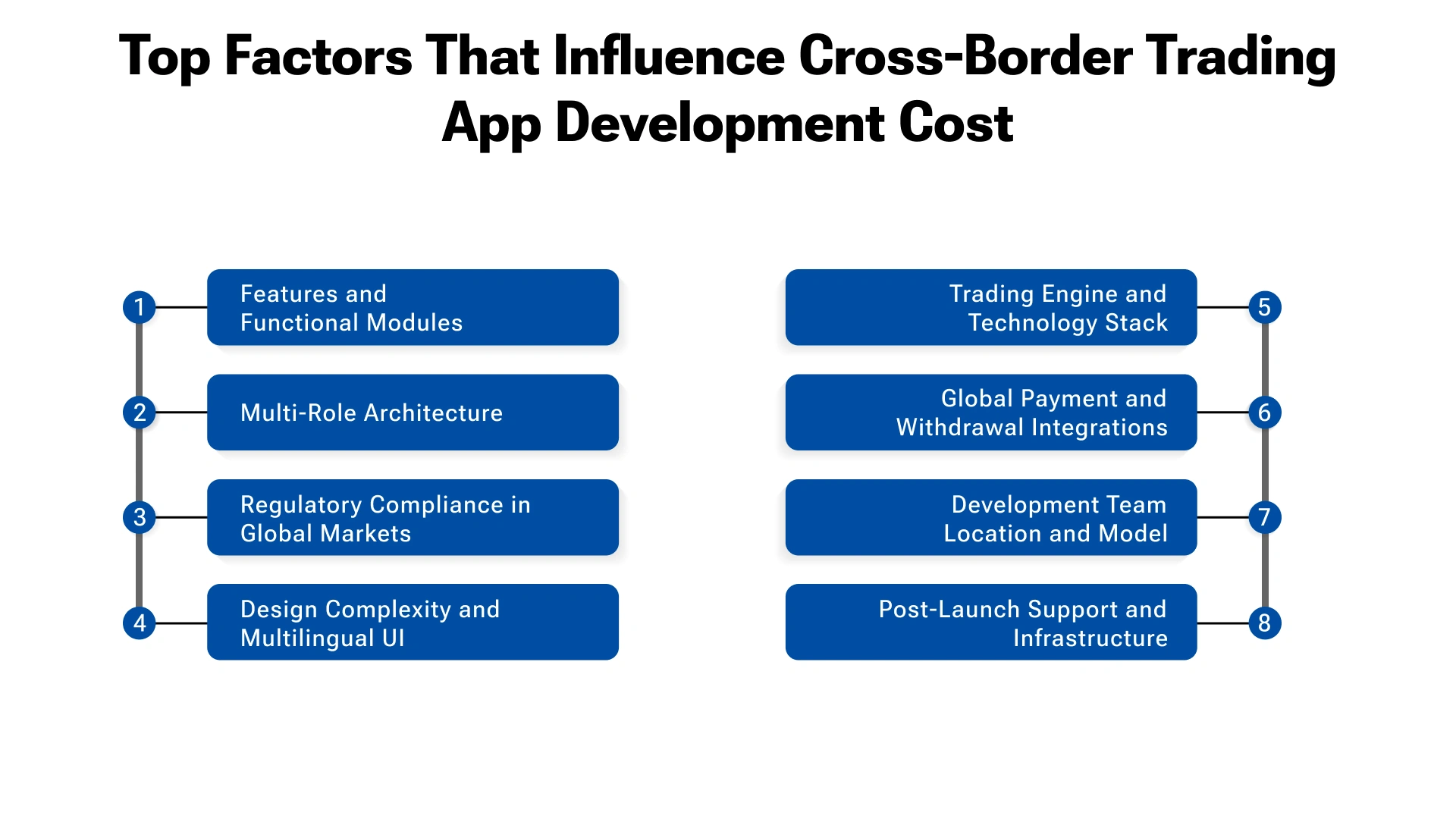
1. Features and Functional Modules
The core feature set has the biggest impact on development cost. A basic trading app may only support simple buy/sell functionality, while a more complex platform includes market data integration, AI-based recommendations, real-time alerts, and multi-currency wallets. Each feature adds effort in terms of design, backend logic, APIs, and testing.
| Feature Set | Details | Estimated Cost (AED) |
| Basic Trading Tools | Order placement, watchlist, market prices | AED 92,000 – AED 185,000 ($25K – $50K) |
| Real-Time Market Data | Live feed integrations, stock prices, and news APIs | AED 147,000 – AED 295,000 ($40K – $80K) |
| Multi-Currency Handling | Conversion, wallet balances, and FX calculations | AED 185,000 – AED 367,000 ($50K – $100K) |
| AI-Based Recommendations | Machine learning models, trade signals, predictive analytics | AED 275,000 – AED 477,000 ($75K – $130K) |
2. Multi-Role Architecture
A trading app must often serve different users—retail investors, institutional clients, and administrators. Each user role requires its own interface, permissions, and workflows. This adds complexity in both the frontend and backend and must be handled during planning.
| User Role | Functionality | Estimated Cost (AED) |
| Retail User Interface | Personal dashboard, asset views, investment history | AED 92,000 – AED 220,000 ($25K – $60K) |
| Institutional Interface | Bulk trade execution, portfolio analysis tools | AED 185,000 – AED 367,000 ($50K – $100K) |
| Admin Panel | User management, transaction logs, and content settings | AED 110,000 – AED 220,000 ($30K – $60K) |
3. Regulatory Compliance in Global Markets
Compliance is non-negotiable. Whether it’s SAMA in Saudi Arabia, SEBI in India, or FINCEN and GDPR in the West, your app must meet strict financial regulations. This involves adding secure KYC/AML modules, user verification processes, audit logs, and reporting functions.
| Compliance Area | Details | Estimated Cost (AED) |
| KYC/AML Integration | ID verification, fraud checks, and user screening | AED 92,000 – AED 220,000 ($25K – $60K) |
| Regulatory Reporting | Audit-ready logs, automated tax and transaction reports | AED 147,000 – AED 295,000 ($40K – $80K) |
| Multi-Region Compliance | GDPR, FATCA, CRS, SAMA frameworks, consent tracking | AED 220,000 – AED 367,000 ($60K – $100K) |
4. Design Complexity and Multilingual UI
An app used across countries must be easy to use for people from different cultures. Supporting Arabic, English, and other languages, having responsive layouts, dark mode, and easy accessibility adds design effort and cost. A simple layout costs less, while a refined interface with real-time data and multiple user flows costs more.
| Design Element | Key Features | Estimated Cost (AED) |
| Basic Layout | Single language, standard screens | AED 55,000 – AED 110,000 ($15K – $30K) |
| Multilingual Support | Arabic/English toggle, LTR/RTL layout handling | AED 92,000 – AED 185,000 ($25K – $50K) |
| Advanced UI Elements | Charts, dark mode, animations, accessibility | AED 147,000 – AED 295,000 ($40K – $80K) |
5. Trading Engine and Technology Stack
The trading engine and choice of technology stack is the backbone of your platform. It manages real-time buying and selling, syncs live market data, and connects with stock exchanges. It also supports charting tools, data feeds, and essential third-party APIs. Whether you build it from scratch or use a ready-made solution will significantly affect the cost to develop a cross-border trading app like Interactive Brokers.
| Tech Component | Details | Estimated Cost (AED) |
| Basic Engine | Handles simple orders and updates | AED 185,000 – AED 370,000 ($50K – $100K) |
| Real-Time Integration | FIX protocol, third-party data feeds, charts | AED 295,000 – AED 735,000 ($80K – $200K) |
| Custom Engine | Fully proprietary trading backend | AED 735,000 – AED 1.47M ($200K – $400K) |
6. Global Payment and Withdrawal Integrations
To enable global transactions, your app must integrate with systems like SWIFT, SEPA, ACH, PayPal, and regional banks. Each integration adds layers of complexity, especially when managing currency conversions and regional compliance. This directly affects the cost to develop a cross-border trading app like Interactive Brokers, especially when aiming for high trust and seamless user experience across markets.
| Payment Method | Details | Estimated Cost (AED) |
| Basic Gateways | Visa/Mastercard, bank transfers | AED 92,000 – AED 185,000 ($25K – $50K) |
| Global Payments | SWIFT, SEPA, PayPal, crypto wallets | AED 147,000 – AED 295,000 ($40K – $80K) |
| Custom Local Setup | Connect with local banks, regional currency handling | AED 185,000 – AED 370,000 ($50K – $100K) |
7. Development Team Location and Model
Where your developers are based and how you hire them affects your budget. UAE-based teams cost more but offer local understanding. Offshore teams are affordable but need clear communication and strong project management.
| Team Type | Location & Hiring Model | Estimated Hourly Rate (AED) |
| UAE (In-house) | High cost, full control | AED 255 – AED 440 ($70 – $120) |
| Eastern Europe | Skilled, affordable | AED 150 – AED 255 ($40 – $70) |
| India/Asia Offshore | Cost-effective, requires project oversight | AED 90 – AED 185 ($25 – $50) |
8. Post-Launch Support and Infrastructure
Once the app is live, you’ll need ongoing updates and maintenance support, bug fixes, server monitoring, and customer support. You’ll also pay for hosting, analytics tools, and security maintenance. These costs are monthly and grow as your user base expands.
| Support Category | Description | Estimated Monthly Cost (AED) |
| Basic Maintenance | Fixes, minor updates | AED 18,500 – AED 37,000 ($5K – $10K) |
| Full Support Package | Includes analytics, performance, and uptime monitoring | AED 55,000 – AED 92,000 ($15K – $25K) |
| Infrastructure Tools | Hosting, database, firewall, backups | AED 18,500 – AED 37,000 ($5K – $10K) |
Hidden Costs in Cross-Border Trading App Development UAE
While the development phase gets most of the attention, several hidden costs can impact your budget after launch, like maintenance, cloud hosting, API fees, and regulatory updates. These factors significantly increase the cost to develop a cross-border trading app like Interactive Brokers, especially as the platform scales and serves multiple regions. Planning for them early helps avoid budget overruns later.
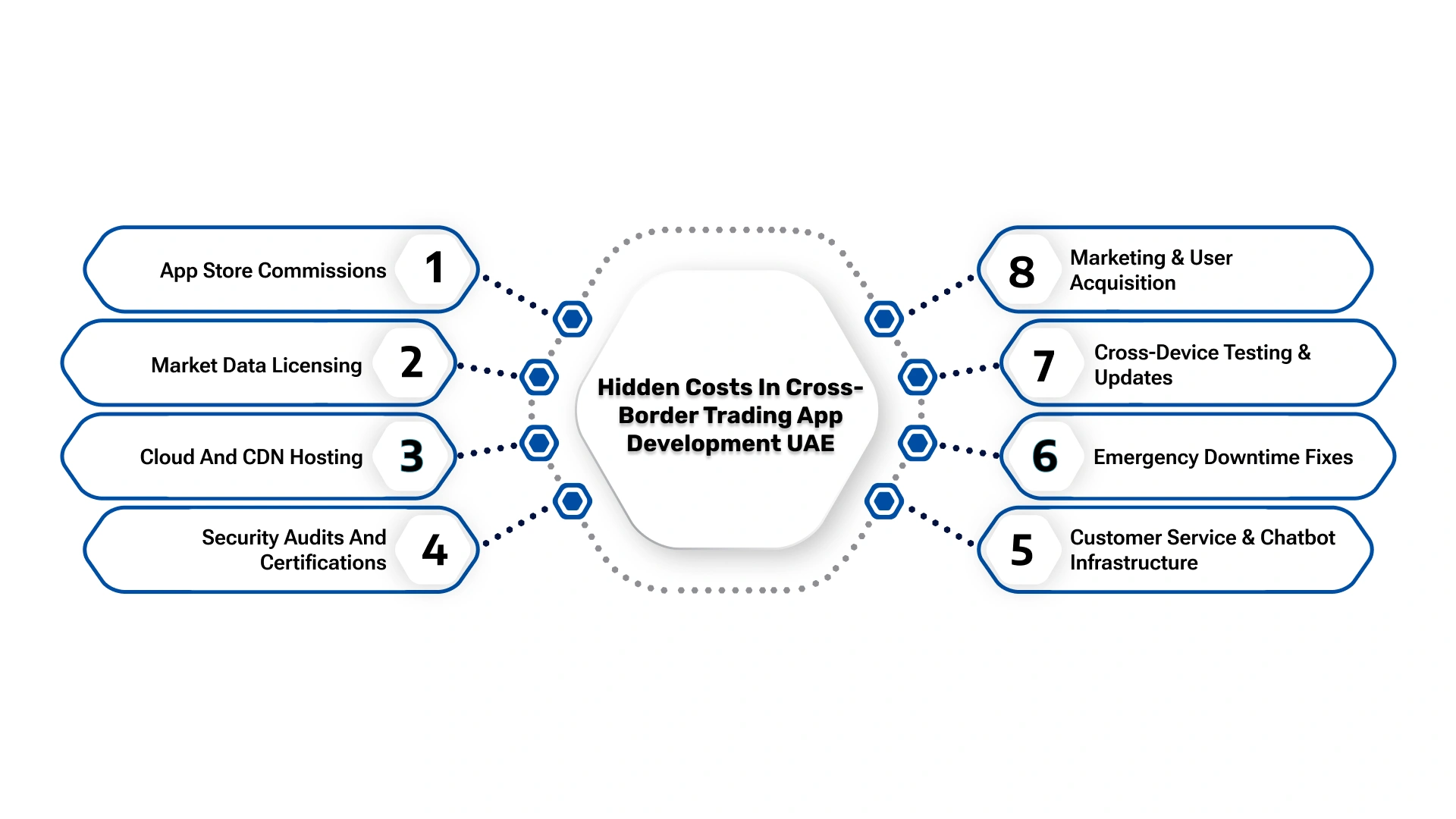
App Store Commissions
Platforms like the Apple App Store and Google Play charge a 15% to 30% commission on in-app purchases and subscriptions, which can eat into your revenue if your app includes monetized services.
Market Data Licensing
Subscribing to live financial data from sources like Bloomberg or Refinitiv is a significant recurring expense in trading app development UAE projects. Depending on the scope, depth, and number of exchange feeds required, these subscriptions can range from AED 18,500 to AED 92,000 per month ($5,000 to $25,000), making them a key consideration for long-term budgeting.
Cloud and CDN hosting
Hosting your trading platform on cloud services like AWS or Azure, along with content delivery for global users, typically costs AED 11,000 to AED 37,000 per month ($3,000 to $10,000), based on usage.
Security Audits and Certifications
To maintain trust and comply with global financial standards, you’ll need third-party audits like SOC 2 or ISO 27001, which can cost around AED 73,500 to AED 220,000 per year ($20,000 to $60,000).
Customer service & chatbot infrastructure
Running a 24x7 support operation with tools like Zendesk or Intercom adds recurring expenses of AED 18,500 to AED 92,000 per month ($5,000 to $25,000), depending on the support load.
Emergency Downtime Fixes
System crashes, bugs, or performance issues in live environments often demand urgent intervention, with each incident potentially costing AED 18,500 to AED 55,000 ($5,000 to $15,000).
Cross-device testing & updates
Ongoing testing and maintenance are critical for trading app development UAE projects to ensure the app remains compatible across Android, iOS, tablets, and new OS updates. These post-launch activities can cost between AED 11,000 to AED 37,000 per month ($3,000 to $10,000), depending on app complexity and user base size.
Marketing & user acquisition
Building visibility post-launch requires a solid marketing budget. Campaigns, influencer partnerships, and referral rewards can quickly total AED 220,000 to AED 735,000 ($60,000 to $200,000) within the first year.
[Also Read: How Much Does It Cost to Build a Crypto Wallet App?]
How to Reduce Cross-Border Trading App Development Costs
Building a trading app doesn’t always need to start with a multimillion-dirham budget. With the right strategies, you can reduce the cost to develop trading app like Interactive Brokers without compromising on quality, performance, or regulatory compliance. Smart planning, phased development, and expert outsourcing make a big difference.
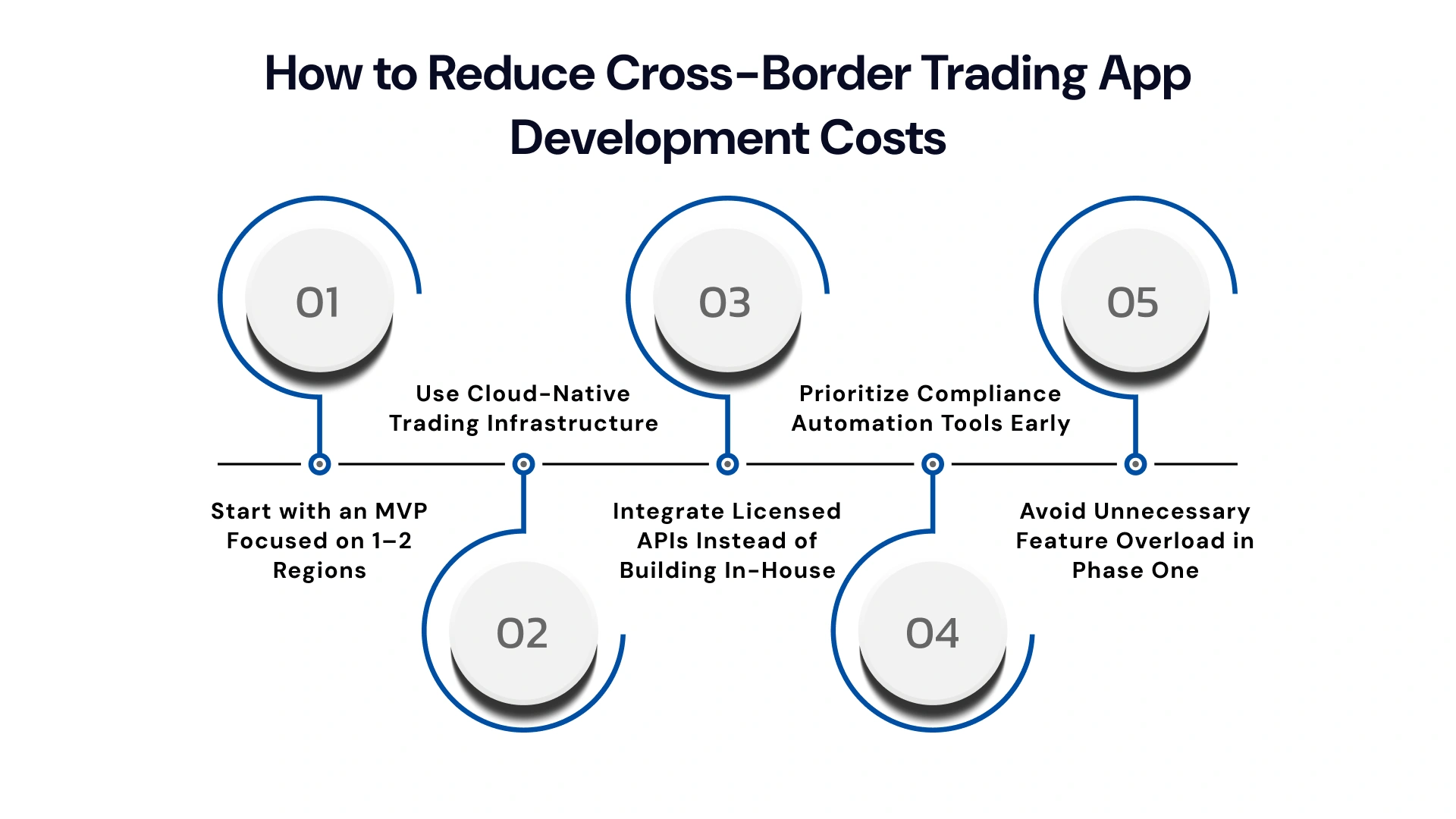
Start with an MVP Focused on 1–2 Regions
Instead of building a global product upfront, begin with an MVP targeted at key regions like the UAE and one neighbouring market. Include only essential features such as onboarding, basic trading functionality, and wallet integration. This phased approach helps you reduce the cost to develop trading app like Interactive Brokers, keeping your initial budget closer to AED 735,000 – AED 1.1M ($200K – $300K) while validating your concept early.
Use Cloud-Native Trading Infrastructure
Avoid investing in physical servers or private data centres. Cloud-based services and platforms like AWS, Azure, or Google Cloud offer secure, scalable environments where you pay only for what you use. This reduces upfront costs and helps manage scaling expenses based on real user growth.
Integrate Licensed APIs Instead of Building In-House
Rather than building every service from scratch, use licensed APIs for payments, market data, identity verification, and trading analytics. These APIs are secure, fast to integrate, and help you go live quicker while avoiding months of development time and expenses.
Prioritize Compliance Automation Tools Early
Manual KYC, AML checks, and audit reporting are resource-heavy and difficult to scale. By integrating compliance automation tools from the beginning, you reduce reliance on large teams and lower legal risk. This also helps optimise the cost to develop trading app like Interactive Brokers, especially when operating in regulated markets.
Avoid Unnecessary Feature Overload in Phase One
Focus on delivering one or two core user needs in your first release. Skip advanced dashboards, social trading, or AI-driven insights until you have product-market fit. Keeping the scope tight in early stages helps control the cost to develop trading app like Interactive Brokers, allowing you to scale features based on real user demand.
How to Earn Money from a Cross-Border Trading App Like Interactive Brokers
If you're building a trading app modeled after Interactive Brokers, monetization needs to go beyond simple trade commissions. Below are the primary revenue channels used by top trading platforms, along with explanations of how they work and why they matter from a business standpoint:
1. Commission on Trades
Charge users a small fee per transaction, either as a flat rate or a percentage of trade value. While some platforms offer commission-free models, many still monetize through spreads or fees on less liquid assets, derivatives, or international trades. As user volume increases, this becomes a consistent revenue driver.
2. Margin Loan Interest
Users can borrow money to trade larger positions through margin accounts. The platform earns interest on these borrowed funds, similar to how banks earn on loans. This is one of Interactive Brokers’ largest income sources and can contribute 30–40% of total revenue on mature platforms.
3. Subscription Plans
Offer multiple account tiers with enhanced functionality. Free accounts may offer limited access to market data or features, while paid plans can unlock real-time analytics, priority support, algorithmic trading, or portfolio insights. This model creates predictable recurring income.
4. Inactivity & Account Maintenance Fees
Apply fees on dormant accounts or those with low balances. While small per user, they help offset infrastructure and compliance costs, and they nudge users to engage with the app actively or upgrade to premium services.
5. Market Data Sales
Live market data is highly valuable. Charge users for different data levels, such as delayed vs real-time prices, Level I vs Level II order books, or premium indicators. Institutional clients may also pay for access to bulk market feeds via API.
6. Asset Management and Robo-Advisory Fees
Introduce robo-advisory or wealth management features that automatically invest user funds based on preferences. The app earns a percentage of Assets Under Management (AUM), generating a steady income stream without needing manual involvement.
7. Affiliate Revenue from Third-Party Services
Integrate value-added services like insurance, education, or crypto wallets. Earn affiliate or referral commissions for each customer action, such as policy signups or funded accounts on partner platforms.
8. White-Labeling or API Monetization
License your trading infrastructure to other fintechs or brokers under a white-label model. This B2B channel brings in higher-value contracts with recurring licensing fees and setup/customization charges.
9. FX Conversion Charges
Apply small spreads when users convert between currencies to trade internationally. Given that cross-border investors frequently need to convert funds, this passive fee model adds up significantly over time.
10. Learning and Certification Programs
Monetize through education. Offer paid trading courses, beginner certifications, or live strategy sessions. This builds user trust, improves app retention, and creates an ancillary source of recurring revenue.
Tips to Build a Better Trading App Than Interactive Brokers
Interactive Brokers has earned its reputation for global market access and advanced tools, but that doesn’t mean it’s perfect for every user. If you're planning to develop a cross-border trading app, here are the key areas where you can offer a better, more modern experience:

Personalised UI/UX
Avoid the one-size-fits-all approach. Let users customise dashboards, switch between light or dark modes, and reorder modules based on their priorities. A retail trader doesn’t need the same layout as an institutional advisor. To create this kind of adaptable experience, hire UI UX designer teams who understand how to build interfaces that feel personalised, not generic.
Better Onboarding and Education Tools
Don’t overwhelm new users with complex forms or jargon. Use progressive onboarding: introduce features one step at a time. Add simple explainers, visuals, and short how-to videos that help people understand how to start trading without feeling lost.
Faster Global Onboarding
Speed matters, especially when users want to start trading immediately. Use fast KYC tools with support for local IDs, auto-verification, and selfie checks. Aim to reduce onboarding time to under 10 minutes, even for international users. This creates a strong first impression and lowers drop-off.
Real-Time User Analytics and Nudges
Track user actions and gently guide them with relevant messages. If someone frequently checks gold stocks but hasn’t made a trade, suggest curated insights or recent news. If a portfolio drops in value, show tips to rebalance. These nudges make the app feel responsive and helpful, not just transactional.
Smart Tax Optimization Tools
Tax obligations vary by country, and most users aren’t tax experts. Add features that calculate potential tax liability, suggest when to sell for tax savings, and generate reports for filing. This builds trust and loyalty, and users feel like your app protects both their investments and their compliance.
Integrated Learning & Social Forums
Offer built-in access to educational resources like market tutorials, news summaries, and live webinars. Go one step further by creating social forums where users can follow top traders, ask questions, and share strategies. Social learning makes investing less intimidating and more engaging.
Build a Global Cross-Border Trading App With VLink Expertise
If you're looking to build a feature-rich, compliant, and scalable cross-border trading app, VLink offers some of the best trading app development services in UAE.
VLink has deep expertise in fintech platforms, including trading apps, robo-advisors, and digital wallets. Their development teams understand the security and compliance standards required across global markets—covering everything from KYC and AML to GDPR and ISO 27001.
With experience delivering multilingual, regulatory-compliant apps in the UAE, US, and Europe, VLink ensures your trading platform is both locally relevant and globally functional. From real-time trading engines to multi-currency handling and secure API integrations, their team helps you launch faster with long-term reliability.
If you're planning your next fintech product, partner with VLink to build a future-ready trading app that meets user demands and regulatory expectations.
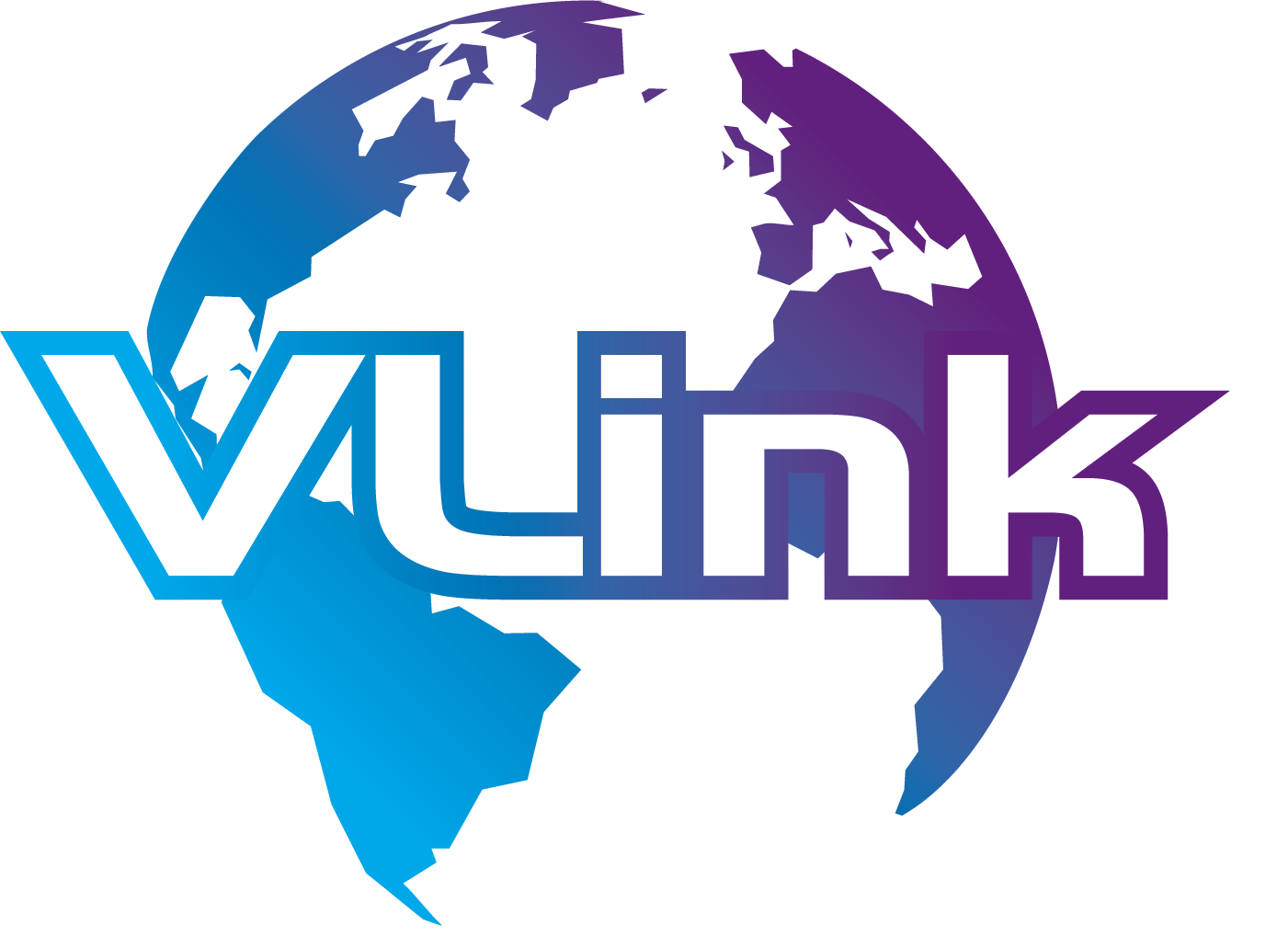








 Shivisha Patel
Shivisha Patel











